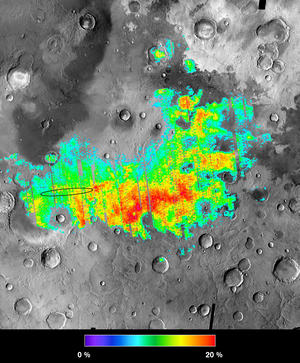On January 24, 2004 - one Mars year ago - NASA's Mars Exploration Rover Opportunity arrived at Mars. After a tense, high-speed entry and descent, the rover, tightly cocooned in airbags, bounced and rolled to a stop inside tiny Eagle Crater on Mars' Meridiani Planum. The landing, which made an interplanetary hole-in-one, was flawless.
A few hours later, Opportunity unpacked itself and turned on a camera. The very first picture captured an outcrop of bedrock - exactly what the spacecraft had been sent millions of miles to find - lying only a few yards away.
If coming to rest inside Eagle Crater was a giant stroke of luck, chance played no role at all in the choice of Meridiani Planum as a landing site. NASA picked Meridiani on the strength of data from two instruments: the Thermal Emission Spectrometer (TES) on the Mars Global Surveyor orbiter and the Thermal Emission Imaging System (THEMIS) on the Mars Odyssey orbiter. Mars Global Surveyor reached Mars in 1997, while Mars Odyssey arrived in 2001.
TES views Mars at wavelengths that isolate and identify rock minerals; each TES pixel covers about 3 by 5 kilometers (2 by 3 miles) on the ground. THEMIS, on the other hand, is a multi-band camera, sensitive to 15 individual colors in the visible and infrared. It can spot details on the ground 18 meters (60 feet) across at visible wavelengths and 100 meters (330 feet) across in the infrared.
Touched By Water
Looking down from orbit, TES detected an area the size of Illinois rich in a mineral called crystalline gray hematite. On Earth, this iron-oxide mineral usually forms in association with water. Its presence on Mars told mission planners and scientists that Meridiani was an excellent place to send a rover to look for once-wet environments.
"Finding that hematite deposit was one of the shining achievements of TES," says Phil Christensen of Arizona State University's Mars Space Flight Facility. Christensen, who developed both TES and THEMIS, is a professor of geosciences at ASU and principal investigator for the two instruments. "As far as I was concerned, finding hematite accomplished TES' mission."
Although TES identified hematite, it took data from THEMIS to clinch the case for a Meridiani landing. Christensen explains, "THEMIS showed what the hematite-bearing unit looked like and that let us map its boundaries. These indicated the hematite most probably formed in a body of standing water and not, for example, from volcanic ash falling from the sky."
THEMIS then "cemented the deal," as Christensen puts it, when the instrument's nighttime images showed the site was safe to land on. It was littered neither with large rocks nor extensive patches of dust, two common traps that await Mars landers.
Son of TES
While the role of TES in choosing a rover landing site is over, the instrument still has an ongoing connection to the Mars rovers. Both Opportunity and Spirit rovers carry a portable version called Mini-TES, short for Miniature Thermal Emission Spectrometer. Christensen is the developer and principal investigator for Mini-TES as well.
In a ground-based echo of what TES did from orbit, Mini-TES acts as a scout for rover scientists. The instrument can look ahead and identify possible targets of mineralogical interest among the outcrops, loose rocks, and soils around the rover. This ability has proved of particular value with the Spirit rover, which is exploring the complex and jumbled geology of the Columbia Hills inside Gusev Crater.
"When Spirit first landed, it was on the lava plains of Gusev," says Steve Ruff of Arizona State University. He is the scientist now in charge of day-to-day operations with Mini-TES. "The rocks were pretty much all the same - dusty blocks of basalt."
But when Spirit reached the Columbia Hills, the geological scene changed, becoming far more varied. On numerous occasions, Ruff explains that Mini-TES has guided the rover drivers. Whenever an interesting rock appears in a photo shot by one of the rover's cameras, Mini-TES will spend about 15 minutes taking its spectrum to investigate the rock's mineral content. "We've learned now to look for dark rocks," says Ruff, noting these are often dust-free.
"If we spot a dark rock with an interesting texture, we'll favor that one over a different dark rock," explains Ruff. The choosy approach has paid off. In the Columbia Hills, Spirit has found roughly a dozen different rock types, and as Ruff describes it, perhaps two or three times that number await more precise evaluation.
"Every time Mini-TES has said to us, 'Hey, team, there's something worth looking at over there, let's drive to it,' that has paid off in a new rock type," says Ruff. "Mini-TES has never yet been wrong."
Letting the Minerals Speak
Looking back on Opportunity's site selection, Christensen notes, "From the TES and THEMIS perspective, Meridiani really was the mother-lode. It was this incredible beacon screaming out that something unusual happened here. No other place on the planet came even close."
He adds, "This was the first landing site on any planet that was picked on mineral grounds. The Apollo sites and the previous Mars sites were all based on morphology - what the sites looked like." If pictures were all anyone used with Meridiani, he says, no one would have chosen to go there.
"Opportunity is an outstanding success," Christensen says. "A wonderful spacecraft sent to a perfect site."
Download a
PDF (816 Kb) of the scientific paper that argued the case for abundant water at Meridiani Planum.
